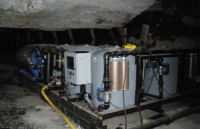Mining Topic: Inertization Technologies
What is the health and safety problem?
To reduce the risk of explosions in mines, a safe and efficient method is needed to render and maintain mined-out or abandoned areas of a mine in an inert state. An area is considered to be inert when the atmosphere in that area will not sustain combustion, including from ignitions. A sealed mine area can be rendered inert by reducing the oxygen in the atmosphere, through the addition of inert gases such as nitrogen or carbon dioxide, or by increasing the amount of existing flammable gas, such as methane, to the point that the gas is noncombustible relative to the oxygen concentration.
What is the extent of the problem?
Mine seals are used in underground coal mines throughout the United States to isolate abandoned mining areas from the active mine workings. Sealing is often a safer alternative to ventilation, since continued ventilation of abandoned areas requires continued inspection of the areas by qualified workers and also may divert air away from other areas where mine workers are engaged in ongoing operations. If the abandoned areas are isolated with seals at a rated strength of 120 psi, monitoring and inerting are not required since the seals have sufficient strength to contain an explosion. If the abandoned areas are isolated with seals at a rated strength of 50 psi, the sealed area must be monitored to ensure the area doesn´t contain an explosive mixture of gases. In these cases, inerting technology can be used maintain a non-explosive atmosphere.
The Mine Improvement and New Emergency Response Act (MINER Act) of 2006 and its later amendments set forth guidelines for seal strength, design, maintenance, and monitoring of sealed areas. The MINER Act also specifies both oxygen and methane concentrations necessary to inert the atmosphere in sealed areas of a mine.
How is the NIOSH Mining program addressing this problem?

Nitrogen gas generating system.
Under a contract awarded by the Office of Mine Safety and Health Research (OMSHR), On Site Gas Systems built a mobile in-mine nitrogen generation system that can be used to extract nitrogen gas from the mine atmosphere and deliver that generated gas to a sealed mine area and render it inert. The nitrogen generation plant is sized to fit on a standard shield car or mine dolly for easy transport in and around an underground mine. Each unit is capable of producing about 300 standard cubic feet per minute of nitrogen gas at ambient mine conditions.
What are the significant findings?
The mobile in-mine nitrogen generation system, funded by the OMSHR, was a successful new technology development and the system has been commercialized for the mining industry. The new system has many technological advantages including size reduction, operating efficiency, more tolerance to ambient conditions, less maintenance requirements and a longer lifespan. The systems are in use in several operating underground coal mines and the technology is a viable option for any mine that needs assistance for inerting a sealed area.
Where are the next steps?
Research and development of the system are completed and the technology has been successfully demonstrated at operating mine sites. Commercialization is completed and the technology is available to the mining community.
See Also
- Coal Mine Inertisation By Remote Application
- Comparison of Methods: Dynamic Versus Hydrostatic Testing of Mine Ventilation Seals
- Explosion Pressure Design Criteria for New Seals in U.S. Coal Mines
- Performance Comparison of Rescue Breathing Apparatus
- Progress Toward Improved Engineering of Seals and Sealed Areas of Coal Mines
- Remote Mine Fire Suppression Technology
- Safe and Economical Inerting of Sealed Mine Areas
- Use of CFD Modeling to Study Inert Gas Injection into a Sealed Mine Area
- The Use of Nitrogen-Enhanced Foam at the Pinnacle Mine Fire
- Use of Pressure Swing Adsorption Technology to Inert Sealed Mine Areas with Nitrogen
- Page last reviewed: 9/16/2012
- Page last updated: 9/22/2015
- Content source: National Institute for Occupational Safety and Health, Mining Program


 ShareCompartir
ShareCompartir